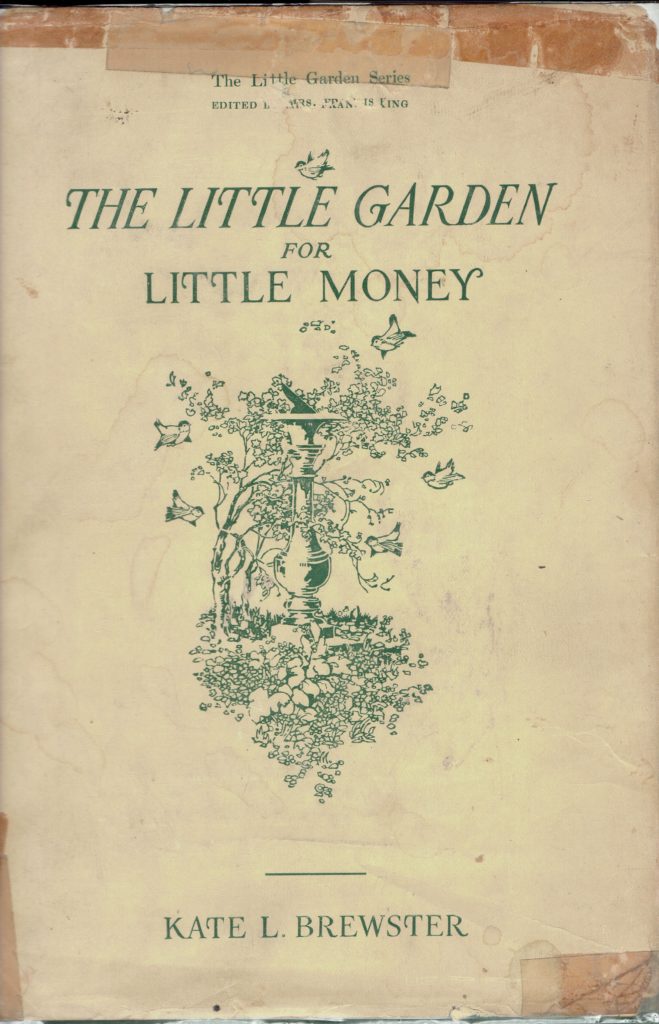
(Inspired by a podcast called Lost Ladies of Lit, I’ve decided to write an occasional post about lost ladies of garden writing.)
We begin with Kate L. Brewster, simply because her book was the first one I grabbed when I was going through my personal library of old gardening books.
The Little Garden for Little Money, by Kate L. Brewster (1924) is part of a series of books called The Little Garden Series edited by Mrs. Francis King (Louisa Yeomans King).
Brewster notes in the forward of the book that what the book wanted to call itself was “The Fool-proof Garden.” It’s 109 pages of Brewster’s advice for people with small gardens and not much money to spend on them. (More in a bit on her garden being not being quite little or inexpensive.)
From the editor’s preface, we find out that Kate L. Brewster is also referred to by her married name, Mrs. Walter S. Brewster, and was a founder and one of the first vice-presidents of the Garden Club of America. (If you want to read a history of the Garden Club of America, check out The Garden Club of America: 100 Years of a Growing Legacy, by William Seale (2013).)
Kate was also the second editor of the Bulletin of the Garden Club of America from 1915-1921, “bringing up that charming publication in size from eight pages to its present sixty-four.”
When her garden book was published in 1924, she was in her third year as the president of the Garden Club of Lake Forest, Illinois, and was a life member of the New York Horticultural Society as well as a member of the Royal Horticultural Society, London. I think, based on my further online searches that The Little Garden for Little Money was the only book she wrote.
Now let’s see what the internet tells us!
Kate L. Brewster was born in 1879 and died in 1947. She married Walter S. Brewster in 1903. On the Find-a-Grave site, someone added a little newspaper snippet about her wedding, which was unusual because she didn’t have any parties leading up to the wedding and it was a small wedding in her parent’s home. That site also lists two children, a girl born in 1904 and a boy born in 1910, and includes a rather grainy picture of Kate in a garden “gathering fragrant flowers from her collection.”
If we head over to Google’s book site, we can explore those garden club bulletins she edited. Be careful as this might be a deep rabbit hole because as noted above, Kate increased the size of them substantially.
Searching elsewhere for information on Mrs. Walter S. Brewster, and also searching on her maiden name, Katherine Lancaster, I found that Kate was “a chairman of the committee for the Fatherless Children of France, and was given the Medal of Legion of Honor in recognition of her war work.”
In addition to her work during World War I (which may have included spending time in France with the American Red Cross, which I put in my notes but can’t find the website reference for now) and her work as a garden writer and editor, Kate and her husband helped found the Chicago Art Institute. Some of their correspondence related to buying and selling art— including pieces by Picasso and Cezanne—is archived on a Smithsonian website. They seemed to have several paintings others wanted to buy.
But back to gardening! Kate was also listed as the landscape designer for Edgecliff, a house and garden in Winnetka, Illinois. No doubt she would also have designed her own gardens on 25 acres (hardly little) at her home in Lake Forest, which was called Covin Tree. (Yes, I had to look up “covin tree” to find out that it is “a tree in front of a Scottish mansion beneath which a laird or owner formerly met his visitors or his retainers.”)
Noted in the description of her garden is that Kate was likely influenced by British garden designers William Robinson and Gertrude Jekyll. She also had gardens named April, May, and June which were planted for peak bloom in those months. In one of the Bulletins of the Garden Club of America, her garden was described as an Italian-style garden.
I also discovered in my long, winding searches that there is a bearded iris and also a daffodil named ‘Mrs. Walter Brewster’ but I cannot find either one for sale. Like our first lost lady of garden writing, these plants may be hidden in someone’s garden, as this book was hidden on my library shelf, with the owner not realizing what a fascinating life Kate L. Brewster (Mrs. Walter S. Brewster) lived.
I hope you found this little jaunt through history as interesting as I did. If you know of a lost lady of garden writing you think I should re-discover, let me know in a comment or email and I’ll check her out.
(Dee Nash and I talked bout Kate L. Brewster on a recent podcast episode of The Gardenangelists.)


That was fascinating. I guess the covin tree was like the council oaks here.